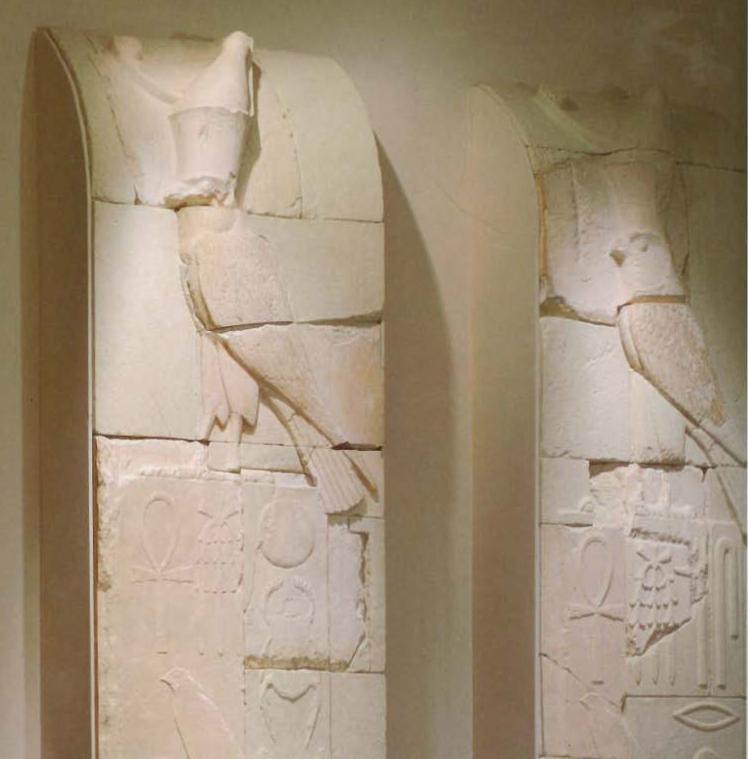Statue of Horus
Its freewheeling mastery of the sky and the fierce arrogance of its sharp beak and darting glance made the falcon one of the major embodiments of divinity for the ancient Egyptians. There were a number of falcon gods, including Sokar, Nemty, and the warlike Montu. Foremost among them, and one of the most important of all Egyptian gods, was Horus, in whom the majesty and lordliness of the bird were preeminent. Originally a sky god, Horus became the tutelary deity of Upper Egypt. From the beginning of Dynasty 1 (c. 3100 BCE), he was identified with kingship, both in a general sense and as embodying the divinity inherent in each reigning king, whose first title was always “Horus.” Like all the major gods, Horus had many aspects and could be represented as a falcon-headed man, as a naked child, or as Harakhty (“Horus of the Horizon,” god of the sun in the daytime sky)—a male figure, sometimes mummiform, with a bird’s head crowned by a sun disk. When emphasis was on his role as the great national and royal god, however, he often appeared in his original, wholly animal form, and it is thus that he is shown in this superb bronze statuette, made sometime during the last four centuries BCE.
Roles of Horus
Horus was one of the most powerful and important gods of ancient Egypt, and was a member of the Great Ennead of Heliopolis.
He appeared in many forms among them Ra-Herakhty, Horus the Elder, Horus the Younger and Horus the Child. Horus the Elder was the son of Geb, the earth god and Nut, the sky goddess, while Horus the Younger was the son of Isis and Osiris. Ra-Herakhty was the association of Horus and Ra representing the early morning sun. Horus was depicted in numerous forms such as a winged falcon, winged sun disk, a falcon-headed man. ‘Horus, the great god, lord of the sky, son of Ra, he who carries the skies,… …”. In the Old Kingdom Horus was regarded as ‘lord of the sunrise, hence ‘Horus in the horizon’.
The legend of Horus tells us that the followers of Horus celebrated his victory over Seth in Edfu. At this event Ra ordered that the winged disk, the form that Horus had assumed when he battled as Ra-Herakhty, must be kept over doors as a symbol that god protected all who entered. Throughout the history of ancient Egypt, the main cult centre of Horus was Edfu. The temple of Edfu built by Ptolemy III is one of the best preserved temples of ancient Egypt. A grey granite statue of the falcon Horus at the entrance is one of the most masterly representations of Horus.
One of the most important roles of Horus was as the protector of the kings. It is the association of the king with Horus that gave the king his divinity. It became a tradition to write the king’s name in a serekh below the sign of Horus. The king was Horus while alive and when dead he became Osiris, and the new king then took the form of Horus.
Horus and Seth
Throughout the Early Dynastic period and the Old Kingdom, Seth and Horus are represented as the two patron deities of the monarchy and as the gods who give victory to the king. In the pyramid texts, the king is regarded as incorporating the two gods, Horus and Seth, or as being aided by them in his trip to the other world. These same texts, however, present allusions to myths in which Horus and Seth are bitter rivals. The oldest form of these is the so-called “Contendings of Horus and Seth,” a kind of historical saga explaining the unity of Egypt in terms of reconciliation, in the person of teh king, of two opposing entities, “the portion of Horus”—Lower Egypt, and “the portion of Seth”—Upper Egypt.
Metropolitan Museum of Art, Egyptian Art, 2001.
Van Seters, John, The Hyksos- A New Investigation. New Haven- Yale Univ. Press, 1966.
Farid Atiya. Ancient Egypt. Farid Atiya Press. Giza, Egypt, 2006. p. 54.





